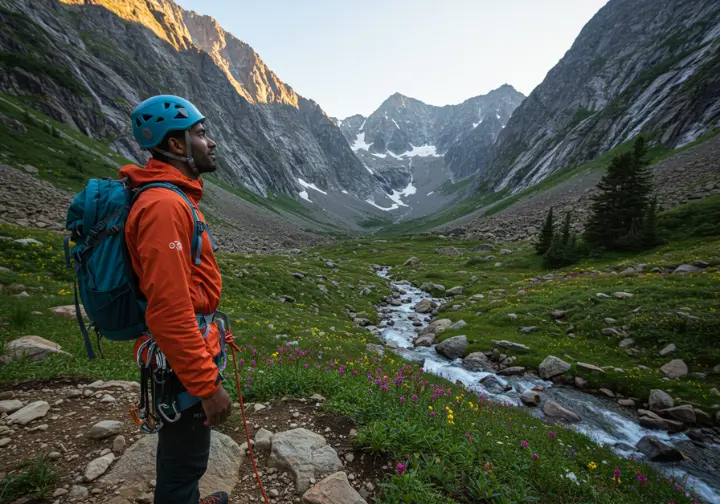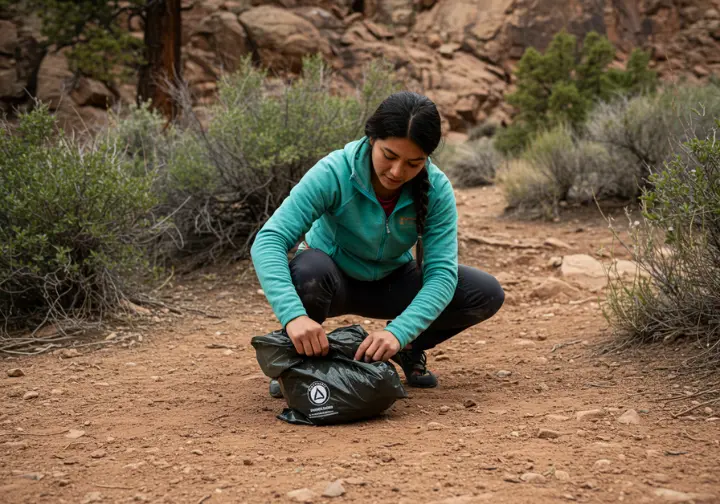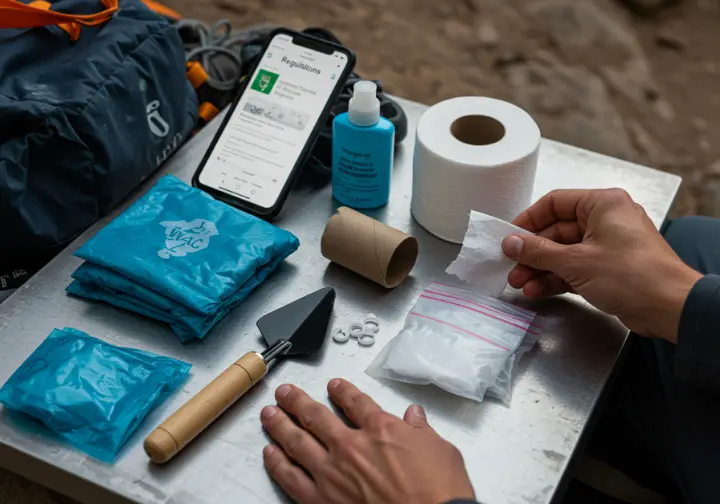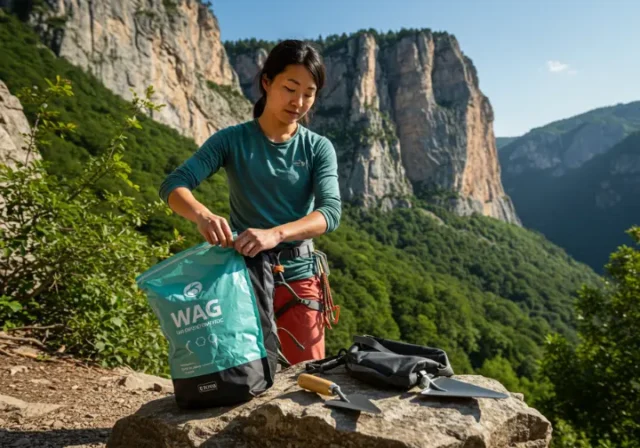In this article
We all have a deep love for pristine, wild climbing areas. That connection comes with a quiet but critical responsibility to protect these places from our own impact. Proper waste disposal isn’t an inconvenient chore; it’s a fundamental and non-negotiable climbing skill for all climbers. With the growing popularity of climbing, our collective human impact, especially from waste, now threatens the very ecosystems and access we cherish. This guide serves as a definitive, practical resource to empower you with the knowledge for proper human waste disposal climbing in any outdoor scenario. We’ll cover everything from why waste management matters to the specific “how-to” techniques for every environment.
The Imperative: Why Waste Management Is Non-Negotiable

The consequences of improper human waste disposal are significant, establishing the critical importance of adopting responsible practices. The impacts and hazards on environmental health, public safety, and our continued access to climbing areas are too severe to ignore. Every single person shares the responsibility to be part of the solution to this sanitation issue.
Environmental Degradation
Improperly disposed human feces introduce a host of dangerous pathogens into the environment, such as E. coli, Giardia, and Cryptosporidium. When left near streams, lakes, or even temporary washes, these pathogens can leach into the water system, contaminating drinking water for both wildlife and humans. The decomposition of human waste is incredibly slow in many climbing environments, particularly in arid, alpine, or arctic regions.
Solid waste like feces can survive for over a year in temperate soil and much longer in deserts, while toilet paper can persist for years, creating long-lasting litter and soil contamination. This is due to a lack of the necessary moisture, microorganisms, and warm temperatures required for rapid breakdown. The presence of human waste also directly harms wildlife; animals can be attracted to the salts in urine or the contents of feces, leading them to dig up soil and ingest harmful substances. For more information from the NYSDEC, you can read about the dangers of pathogens in human feces.
Public Health Risks
Human waste acts as a vector for numerous diseases that can be transmitted to other recreationists. Pathogens from bodily waste can be spread through direct contact with contaminated soil or water, or indirectly by insects that are attracted to exposed waste. These pathogens can remain viable in the soil of a shallowly-dug cathole for up to a year, posing a long-term risk to anyone recreating in the area. This creates a cumulative public health hazard in popular areas.
In high-altitude environments like Mount Everest, the massive accumulation of human waste (over 5,400 kg annually) poses severe health risks, including cholera and hepatitis, to local communities. As glaciers melt, they expose previously deposited waste, contaminating the water sources these communities rely on. This problem is part of the larger discussion about the human impact on Everest.
The Threat to Climbing Access
Improper waste disposal and poor crag hygiene are primary concerns for land managers from agencies like the National Park Service (NPS), U.S. Forest Service (USFS), and Bureau of Land Management (BLM). It creates unsanitary conditions and environmental damage that can lead to stricter regulations or even complete area closures. The accumulation of human waste has directly led to access threats in climbing areas around the world. For example, at Piedra Parada in Argentina, unmanaged waste contributed to a proposal to ban climbing entirely.
Leading climbing advocacy groups like the Access Fund explicitly include “Dispose of human waste properly” in their Climber’s Pact, highlighting its direct connection to maintaining access. The Climber’s Pact is a core set of ethics that every responsible climber should know. Proactive efforts by local climbing organizations (LCOs) to distribute WAG bags and educate climbers are a direct response to this threat, demonstrating that responsible behavior is key to keeping crags open.
The Gold Standard: Best Practices for Climbers

To handle waste disposal properly, it helps to have a clear, hierarchical guide to the available methods. We will explain how to choose the right technique based on regulations and environment, providing detailed instructions to ensure you are always following the best and most ethical practices, whether you’re car camping or on a long thru-hike.
Principle 3: Leave No Trace
The Leave No Trace (LNT) framework provides the core ethical guidelines for minimizing impact, and Principle 3, “Dispose of Waste Properly,” is the foundation for managing human waste. The primary tenets are to “pack it in, pack it out,” utilize toilets when available, and if necessary, use proper cathole techniques. Adhering to LNT means making informed decisions based on the specific context of your climbing area. Factors like local regulations, environment type, and concentration of use dictate whether you should use a WAG bag or dig a cathole.
A key part of LNT is “Plan Ahead and Prepare” (Principle 1), which means researching the waste disposal rules for your destination before you go. This ensures you arrive with the necessary supplies, like a WAG bag or a trowel, and understand the local ethics. These principles are so effective they are often incorporated into the regulations of land management agencies.
Pack It Out: Using WAG Bags
In a growing number of climbing areas—especially those that are high-use or in sensitive desert or alpine environments—the pack-it-out method for solid waste is mandatory. Commercial Waste Alleviation and Gelling (WAG) bags are the most common tool for this. These portable toilet bags, often sold as waste bag kits, typically contain an outer bag, an inner waste collection bag with a gelling/deodorizing powder (“Poo Powder”), toilet paper, and a hand wipe. The powder, sometimes similar to kitty litter, deodorizes waste and renders it inert.
To use a WAG bag, find a private spot 200 feet from water and trails, open the bag system, and defecate directly into the inner bag. After use, place used toilet paper in the same bag, seal the inner bag securely, and then place it inside the puncture-resistant outer bag. The gelling agent solidifies liquids and neutralizes odors, making transport more sanitary. Used WAG bags are typically approved for landfill disposal in regular trash receptacles or a designated trash can, but always check local regulations for municipal waste. Never dispose of used waste bags in pit toilets or a composting toilet, as the plastic bag will not break down. For multi-day big wall climbs, big wall climbers often use “poop tubes,” which are reusable, sealable PVC pipes designed to carry out multiple days’ worth of waste.
The Cathole: When and How
Digging catholes for climbers is a traditional backpacking method, but it is only appropriate where regulations permit and environmental conditions are suitable. It is critical to select a site at least 200 feet (about 70 big steps) from any water, trails, or campsites. Choose an inconspicuous location with deep, dark, organic soil rich in decomposer microorganisms and avoid rocky ground or washes. A proper cathole is essential for sanitation.
Using a dedicated trowel, dig the hole 6 to 8 inches deep and 4 to 6 inches wide. After defecating in the hole, the most environmentally sound practice is to pack out all used toilet paper in a separate, sealable plastic zip bag. TP biodegrades extremely slowly and is often dug up by animals, becoming unsightly litter. After use, backfill the hole with the original soil and tamp it down firmly. Disguise the site with natural materials like leaves to make it blend in and deter animals. Catholes are never appropriate in sensitive desert or alpine environments, on snow, or in high-use areas.
Managing Urine and Pet Waste
Urine generally has less environmental impact than feces, but proper disposal is still important. The best practice is to urinate at least 200 feet from water sources, trails, and campsites, choosing durable surfaces like rocks or gravel. Animals are attracted to the salts in urine and can damage plants or dig up soil to get to them. Avoid urinating at the base of climbs where odor can concentrate. If toilet paper is used, it should always be packed out in a sealable bag.
Pet waste carries similar health and environmental risks as human waste. LNT principles state that pet waste should be treated the same as human waste: either pack it out in a doggy bag or bury it in a proper cathole, depending on local rules. Packing out all garbage and pet waste is increasingly encouraged, especially in sensitive or high-use areas. You can find more details about disposing of waste properly from Leave No Trace.
Gearing Up and Knowing the Rules

A responsible approach involves two key components: assembling the right camping gear and knowing the area-specific rules. Here, we provide actionable checklists and explain how to find the regulations that dictate which disposal methods are allowed at your destination.
Your Essential “Poop Kit”
Every climber should carry a dedicated “poop kit” in their backpack as a fundamental piece of gear, just like a first-aid kit. The core component is your primary waste containment system: one or more commercial WAG bags or a poop tube for big wall climbs. If catholes are a permissible option in the area you’re visiting, a lightweight but sturdy sanitation trowel is essential. Always carry an adequate supply of toilet paper and a small bottle of alcohol-based hand sanitizer.
A critical item in your gear is one or more opaque, sealable plastic bags for packing out used toilet paper and hygiene products. All feminine hygiene products, packaging, and wet wipes must always be packed out, as they do not biodegrade and are considered trash. This entire kit should be a standard part of your packing for any hike or climb.
Navigating Area-Specific Regulations
Waste management regulations are not arbitrary; they are set by land managers to protect fragile ecosystems and manage high visitor use. For example, desert and alpine zones often mandate packing out waste due to extremely slow decomposition rates. Rules vary significantly between locations. In Yosemite National Park, packing out solid waste from big walls is mandatory, while in Joshua Tree, WAG bags are preferred but catholes are a permissible alternative as long as TP is packed out. On Denali, complex rules involve using specific Clean Mountain Cans (CMCs) and removing all waste from the mountain.
The most reliable way to find current rules is on the official land manager’s website. You can also get information from ranger stations, visitor centers, and local climbing organization websites. For car camping, check for any nearby dump station or designated dumpsters for human waste disposal. Always double-check regulations before your trip, as they can change. For more details on specific parks, you can review policies on human waste and trash at Joshua Tree National Park.
Conclusion: A Core Ethic for Every Climber
Improper waste disposal has severe consequences for environmental health, public safety, and our continued ability to access the places we love to climb. Every single climber shares the responsibility to be part of the solution. The clear trend in waste management is toward “pack it out” systems. WAG bags climbing are the most reliable way to protect sensitive environments and should be considered the gold standard. View proper waste management as a core climbing skill, not an afterthought. Assemble a poop kit, carry it every time, know the rules, and set a positive example for other backpackers. By doing so, we collectively invest in the future of climbing, ensuring the crags we love remain healthy and accessible for generations to come.
Frequently Asked Questions about Human Waste Management at the Crag
What is better for the environment: a WAG bag or a cathole? +
Do I really have to pack out my used toilet paper? +
What do I do if I have to poop unexpectedly at a busy crag? +
Can I just bury my dog’s poop in a cathole? +
We are a participant in the Amazon Services LLC Associates Program, an affiliate advertising program designed to provide a means for sites to earn advertising fees by advertising and linking to Amazon.com. As an Amazon Associate I earn from qualifying purchases. We also participate in other affiliate programs. The information provided on this website is provided for entertainment purposes only. We make no representations or warranties of any kind, expressed or implied, about the completeness, accuracy, adequacy, legality, usefulness, reliability, suitability, or availability of the information, or about anything else. Any reliance you place on the information is therefore strictly at your own risk. Additional terms are found in the terms of service.









